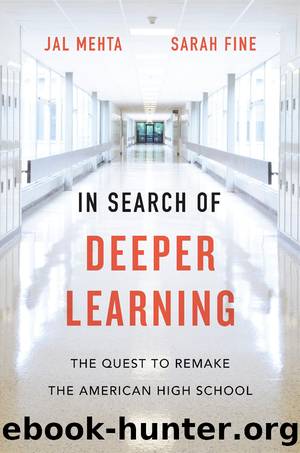In Search of Deeper Learning by Jal Mehta & Sarah Fine

Author:Jal Mehta & Sarah Fine
Language: eng
Format: epub
Publisher: Harvard University Press
Science Electives for the Real World
Another set of classes that students described as particularly powerful were the design, engineering, and green engineering electives. In the design and green engineering classes, students used design processes to develop real-world projects for real-world clients. One of the most celebrated examples was the creation of a pedestrian alert system in Ethiopia. The goal of this project was to reduce the number of road traffic incidents; the group chose to focus on Ethiopia because it had one of the highest road-fatality rates in the world. One of the students had also been born in Ethiopia; he helped to broker a connection with a school in Addis Ababa to gain a greater understanding of the local conditions and context. With the help of an initial $10,000 grant from a nearby university, the students built a machine that could sense the speed of an oncoming car and tell pedestrians whether it would be safe to cross. The machine works on solar power and can be created with recyclable parts. To develop this work, the students found mentors at two prestigious universities, as well as among professional engineers and designers. These mentors helped them through many rounds of critique and iteration, including an extended critique session at a design firm in the city. Their teacher also had spent sixteen years as a designer before teaching high school, an experience that shaped her knowledge and sensibilities. The project was eventually featured in a White House science fair and the students were recognized by President Obama. Obama, one said, âhas surprisingly soft hands but his handshake has a firm grip.â10 Not all projects were this successful, but it was a remarkable example of what high school students can produce when given the opportunity.
The design and engineering courses took a different approach to knowledge and its acquisition. If the logic of most core classes was âhere is a body of material that you need to learn because it might be useful later,â the logic of these electives was âfigure out what you are trying to build, then acquire the knowledge that you need to make it.â Engineering did have a sequenced course of study, and the earlier courses were more organized around content (with applications); later courses were more project-driven on the assumption that students already knew much of the basic content. Overall, though, the people running the engineering program took the stance that what you know is less important than what you can do with what you know. The engineering teachers, Mr. Baker and Ms. Peterson, recalled introducing an instrument, a caliper, and asking students to figure out how to use it. Students went to YouTube, traded ideas with each other, and eventually figured out how to use it. Here we ask about the purpose of this inductive approach:
Interviewer: Wouldnât it be more efficient for you just to show them how to do it?
Mr. Baker: It would be, but thatâs not what I want them to know.
Interviewer: Why not?
Ms. Peterson: And they donât remember it.
Download
This site does not store any files on its server. We only index and link to content provided by other sites. Please contact the content providers to delete copyright contents if any and email us, we'll remove relevant links or contents immediately.
| Administration | Assessment |
| Educational Psychology | Experimental Methods |
| History | Language Experience Approach |
| Philosophy & Social Aspects | Reform & Policy |
| Research |
The Art of Coaching Workbook by Elena Aguilar(48034)
Trainspotting by Irvine Welsh(20043)
Twilight of the Idols With the Antichrist and Ecce Homo by Friedrich Nietzsche(17703)
Fangirl by Rainbow Rowell(7825)
Periodization Training for Sports by Tudor Bompa(7323)
Change Your Questions, Change Your Life by Marilee Adams(6637)
This Is How You Lose Her by Junot Diaz(5753)
Grit by Angela Duckworth(4728)
Red Sparrow by Jason Matthews(4654)
Asking the Right Questions: A Guide to Critical Thinking by M. Neil Browne & Stuart M. Keeley(4566)
Paper Towns by Green John(4163)
Room 212 by Kate Stewart(4099)
Ken Follett - World without end by Ken Follett(3968)
The Sports Rules Book by Human Kinetics(3581)
Housekeeping by Marilynne Robinson(3396)
The Motorcycle Diaries by Ernesto Che Guevara(3325)
Introduction to Kinesiology by Shirl J. Hoffman(3297)
Exercise Technique Manual for Resistance Training by National Strength & Conditioning Association(3286)
Double Down (Diary of a Wimpy Kid Book 11) by Jeff Kinney(3267)
